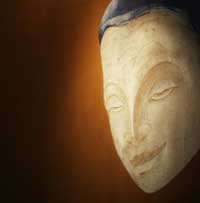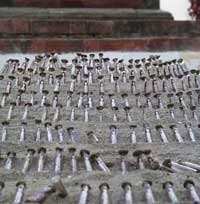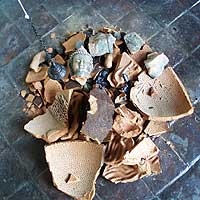 An image of the Bamiyan Buddhas is placed in a low mound of gravel, surrounded by 2,500 little bottles containing fine brown sand in a spiral. Artist Ashmina Ranjit carries a handheld video recorder and films the people who participate in her installation. "Ashmina's True Buddha Mandala. Bottled Buddha for the taking," says a sign next to the mound. Several bottles have already been carried away and leave small finger sized grooves in the sand. This installation is one of many in the Siddhartha Art Gallery's Bamiyan Buddha: Icon of Peace, Hope and Renewal show that is on until 10 January next year.
An image of the Bamiyan Buddhas is placed in a low mound of gravel, surrounded by 2,500 little bottles containing fine brown sand in a spiral. Artist Ashmina Ranjit carries a handheld video recorder and films the people who participate in her installation. "Ashmina's True Buddha Mandala. Bottled Buddha for the taking," says a sign next to the mound. Several bottles have already been carried away and leave small finger sized grooves in the sand. This installation is one of many in the Siddhartha Art Gallery's Bamiyan Buddha: Icon of Peace, Hope and Renewal show that is on until 10 January next year. Red, yellow, white, blue and green-the colours of the five elements float on pots filled with water in Sunita Rana's piece. The visitor is encouraged to step in and out of the water. The symbolic destruction of the water's tranquillity is only temporary-footprints dry up sooner or later and the water slowly grows still. "[S]hould there be a ripple in the peaceful valley like in calm water . the waves shall slowly calm in time and restore the serenity of the valley." The destruction of the Bamiyan Buddhas of Afghanistan, suggests Rana, is temporary in the grand scale of things. The essence of the Buddha was never really destroyed-it was temporarily, physically disturbed, and will settle again into its inexorable calmness.
 The notion that the Buddha and the spirit of rightness he symbolises will live on regardless of acts of hatefulness and destruction permeates the whole show. Inside another gallery, the visitor is greeted by a crude piece of jute and black paper on the floor. The entire construction is a long strip anchored on one end to the corner of an empty picture frame and stretching down the gallery, along the stairs down, and then tapering off. Time goes on, it suggests, punctuated, but never stopped, by small events like the bell hanging from over a pile of shattered debris-disembodied clay statues of the Buddha.
The notion that the Buddha and the spirit of rightness he symbolises will live on regardless of acts of hatefulness and destruction permeates the whole show. Inside another gallery, the visitor is greeted by a crude piece of jute and black paper on the floor. The entire construction is a long strip anchored on one end to the corner of an empty picture frame and stretching down the gallery, along the stairs down, and then tapering off. Time goes on, it suggests, punctuated, but never stopped, by small events like the bell hanging from over a pile of shattered debris-disembodied clay statues of the Buddha. Kalapremi Shrestha's seven terracotta sculptures feature brown organic forms containing brutally shattered fragments of Buddhist statues. The themes of destruction and desolation are ever present, but these ideas are balanced by the tranquillity and scale of Prakaash Chandwadkar's paintings. In the courtyard five six ft-high portraits by Prakaash Chandwadkar stand side by side, depicting the face of the Buddha in brown, yellow, cream, gold and blue. The paints have a sheen that glows across the courtyard. The Buddhas serene expression and the scale of the paintings stand like a silent challenge to the physical destruction inflicted on the Bamiyan Buddhas.
The main gallery displays more of Chandwadkar's paintings, often a photograph of a statue surrounded by colours and light. In addition, there is a video playing on a screen nestled among strips of coloured cloth pouring out of the belly of a large painting of a Bamiyan Buddha. The video, which features Chandwadkar painted in the five colours of work, was made with help from a team of Korean filmmakers.
 The gallery also contains work by Finnish artist Juha Holopainen and Ragini Upadhyay-Grela. Most of this show deals with ideas about spirituality and timelessness, loss and continuity, Holopainen's Ignorance is more direct, depicting blank outlines where the Buddhas ought to be with wild dogs running about on the desert plains of Afghanistan. Upadhyay-Grela's Buddha, Truth and Sun, if less conspicuous than Chandwadkar's large portraits, are also significant pieces. "In my artwork, I have tried to display the Buddha in all his shining wisdom," she says. "It is there, and will stay with us, in our hearts and souls, despite the fact that we will miss forever the beauty and harmony of the Bamiyan Buddha statues."
The gallery also contains work by Finnish artist Juha Holopainen and Ragini Upadhyay-Grela. Most of this show deals with ideas about spirituality and timelessness, loss and continuity, Holopainen's Ignorance is more direct, depicting blank outlines where the Buddhas ought to be with wild dogs running about on the desert plains of Afghanistan. Upadhyay-Grela's Buddha, Truth and Sun, if less conspicuous than Chandwadkar's large portraits, are also significant pieces. "In my artwork, I have tried to display the Buddha in all his shining wisdom," she says. "It is there, and will stay with us, in our hearts and souls, despite the fact that we will miss forever the beauty and harmony of the Bamiyan Buddha statues." 

